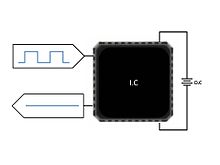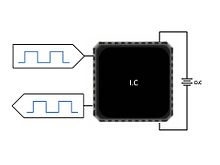The aging process of an IC is relative to its standard use conditions. The tables below provide reference to various commonly used products and the conditions under which they are used.
Reliability engineers are tasked with verifying the adequate stress duration. For example, for an activation energy of 0.7eV, a stress temperature of 125 °C and a use temperature of 55 °C, an expected operational life of five years is represented by a 557-hour HTOL experiment.
Example
Number of Failures = r
Number of Devices = D
Test Hours per Device = H
Celsius + 273 = T (Calculation Temperature in Kelvin)
Test Temperature (HTRB or other burn-in temperature)= 
Use Temperature (standardized at 55 °C or 328K) = 
Activation Energy (eV) = 
 Chi Squared/2 is the probability estimation for number of failures at α and ν
Chi Squared/2 is the probability estimation for number of failures at α and ν
- Confidence Level for X^2 distribution; reliability calculations use α=60% or .60 = α (alpha)
- Degrees of Freedom for
 distribution; reliability calculations use ν=2r + 2. = ν (nu)
distribution; reliability calculations use ν=2r + 2. = ν (nu)
Acceleration Factor from the Arrhenius equation = 
Boltzmann's Constant (  ) = 8.617 x 10e-5 eV/K
) = 8.617 x 10e-5 eV/K
Device Hours (DH) = D x H
Equivalent Device Hours (EDH) = D x H x 
Failure Rate per hour = 
Failures in Time = Failure Rate per billion hours = FIT = 
Mean Time to Failure = MTTF
Where the Acceleration Factor from the Arrhenius equation is: 
Failure Rate per hour = 
Failures in Time = Failure Rate per billion hours = FIT = 
Mean Time to Failure in hours = 
Mean Time to Failure in years=  ´
´
In case you want to calculate the acceleration factor including the Humidity the so-called Highly accelerated stress test (HAST), then:
the Acceleration Factor from the Arrhenius equation would be: 
where  is the stress test relative humidity (in percentage). Typically is 85%.
is the stress test relative humidity (in percentage). Typically is 85%.
where  is the typical use relative humidity (in percentage). Typically this is measured at the chip surface ca. 10–20%.
is the typical use relative humidity (in percentage). Typically this is measured at the chip surface ca. 10–20%.
where  is the failure mechanism scale factor. Which is a value between 0.1 and 0.15.
is the failure mechanism scale factor. Which is a value between 0.1 and 0.15.
In case you want to calculate the acceleration factor including the Humidity (HAST) and voltage stress then:
the Acceleration Factor from the Arrhenius equation would be: 
where  is the stress voltage (in volts). Typically is the VCCx1.4 volts. e.g. 1.8x1.4=2.52 volts.
is the stress voltage (in volts). Typically is the VCCx1.4 volts. e.g. 1.8x1.4=2.52 volts.
where  is the typical usage voltage or VCC (in volts). Typically VCC is 1.8v. Depending on the design.
is the typical usage voltage or VCC (in volts). Typically VCC is 1.8v. Depending on the design.
where  is the failure mechanism scale factor. Which is a value between 0 and 3.0. Typically 0.5 for Silican junction defect.
is the failure mechanism scale factor. Which is a value between 0 and 3.0. Typically 0.5 for Silican junction defect.































